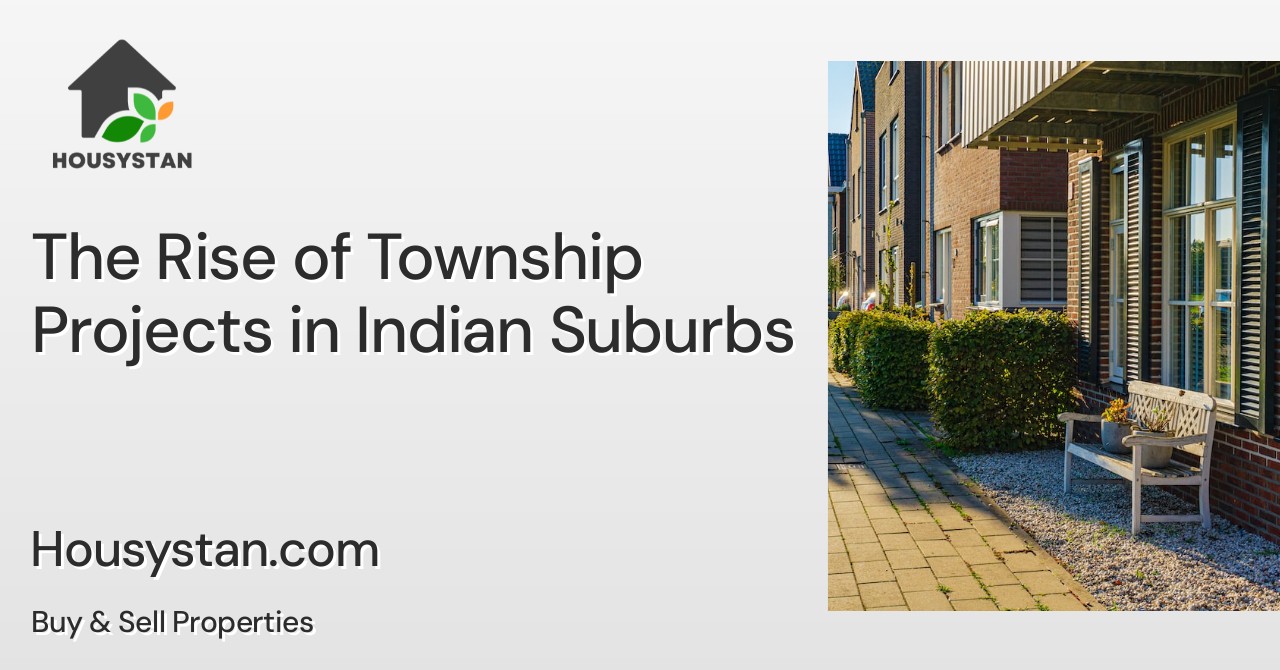The Rise of Township Projects in Indian Suburbs
Read latest blogs and articles from Housystan

The Information mentioned here was last updated on:
9/1/2026The Rise of Township Projects in Indian Suburbs
In recent years, the face of Indian suburbs has been transforming rapidly, and at the forefront of this change are township projects. These planned communities are quickly becoming the solution for many seeking a balanced lifestyle away from the crowded city centers. Township projects offer a one-stop solution with all essential amenities and are redefining suburban living in India.
Understanding Township Projects
- Verified Tenants/Buyers
- Unlimited Property Listing
- Zero subscription/charges fee
What Are Township Projects?
Township projects are large-scale residential developments that often include integrated facilities such as schools, shopping centers, hospitals, and sports complexes. Designed as self-sufficient communities, these projects aim to provide everything a resident might need within a close vicinity.
Key Features of Township Projects:
- Integrated Living: Combining residential, commercial, and recreational spaces.
- Essential Amenities: Including supermarkets, gyms, swimming pools, and parks.
- Enhanced Security: Gated communities with 24/7 surveillance and security personnel.
- Sustainability: Use of green technologies and environmentally friendly practices.
The Driving Forces Behind Their Popularity
Urbanization and Population Pressure
As cities grow, the urban core becomes increasingly congested. This congestion drives people to seek quieter, more spacious living arrangements in suburban areas.
Improved Infrastructure and Connectivity
Government initiatives focus on improving road networks and public transportation, making suburbs more accessible and reducing commute times. This enhanced connectivity makes moving to the suburbs a viable option for many.
Demand for Affordable Housing
Real estate prices in metro cities often climb beyond the reach of average homebuyers. Township projects in suburbs offer a cost-effective alternative without compromising on quality of life.
Quality of Life
Residents enjoy a calmer environment with access to green spaces and modern amenities, contributing to a higher quality of life. Townships minimize daily hassles by having everything a family needs in close proximity.
Focus on Community Living
These projects emphasize shared community spaces, fostering social interaction and a sense of community among residents. This is appealing to families who value a community-oriented lifestyle.
Emerging Hotspots for Township Projects
Mumbai Suburbs
The outskirts of Mumbai have seen a proliferation of township projects, especially in areas like Navi Mumbai, Thane, and Panvel. With improved connectivity via highways and metro lines, these areas are booming with new developments.
Pune
Known as the ‘Oxford of the East’, Pune is an educational and IT hub. Areas like Hinjewadi and Pimpri-Chinchwad are emerging as popular destinations for township projects.
Bengaluru
The IT capital of India, Bengaluru, has township projects sprouting up in areas like Whitefield, Electronic City, and Sarjapur Road, catering to the influx of professionals working in the tech industry.
Gurugram
Adjacent to Delhi, Gurugram has transformed into a modern city with numerous township projects catering to professionals from various industries, thanks to its strategic location and great connectivity.
Chennai
With rapid industrial growth and a strong IT presence, townships in areas like OMR and GST Road are gaining traction in Chennai, attracting homebuyers looking for modern living spaces.
Benefits of Living in Township Projects
Convenience and Accessibility
- All Under One Roof: Residents have access to an array of amenities without needing to commute long distances.
- Proximity to Nature: Incorporation of parks and open spaces provides a connection to nature, enhancing the quality of life.
Security and Safety
- Controlled Access: Gated setups with restricted entry ensure a secure living environment.
- Regular Patrolling: Security personnel maintain safety around the clock, offering peace of mind to the residents.
Investment Appreciation Potential
- Rising Demand: As townships grow in popularity, their value also increases, making them a smart investment.
- Development Scope: Continuous infrastructure improvement promises significant appreciation potential.
Challenges Facing Township Projects
While township projects offer numerous advantages, they also come with their share of challenges.
Approval and Regulations
Developers often face delays and hurdles in acquiring the necessary approvals and permissions from authorities. These regulatory frameworks can sometimes deter timely project completion.
Infrastructure Development Pace
The pace of surrounding infrastructure development can be slower than anticipated, affecting connectivity and market value. It is crucial for external development to keep up with internal growth.
Community Integration
Integrating residents from diverse backgrounds into a cohesive community can be challenging. Efforts are required to foster inclusiveness and a shared cultural ethos.
Sustainability Concerns
Despite best intentions, achieving true sustainability in large developments can be complex. Ensuring all aspects of the township adhere to eco-friendly practices involves meticulous planning and execution.
Potential for Future Growth
Shift Toward Smart Townships
Modern technologies are being leveraged to create smarter township projects with enhanced services like Wi-Fi zones, automated waste management, and digital security systems.
Government Initiatives
Programs focused on urban development and affordable housing, such as the Pradhan Mantri Awas Yojana, ave encouraged investment in township projects. They continue to make such developments more accessible for the common person.
Increased Private Investment
The growing demand for township projects has attracted significant private investment into real estate development, further accelerating the expansion of such projects across the country.
Focus on Sustainable Living
With a rising awareness of environmental issues, developers are now emphasizing sustainable practices. This focus attracts environmentally conscious buyers, further driving demand.
To explore current township projects or get insights into specific localities, readers might visit real estate portals or consult with local estate agents who have a comprehensive understanding of the market dynamics in these emerging areas. For further reading, check out articles on suburban development that discuss infrastructure growth and real estate trends.